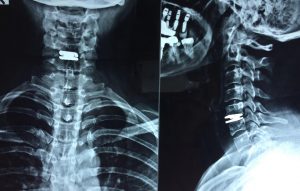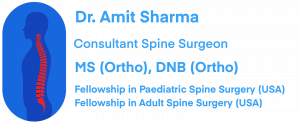Disc Replacement Surgery
Disc Replacement Surgery
Artificial disc replacement surgery is implantation of a “mobile” device in intervertebral disc space after discectomy. It maintains motion at operated level unlike spine fusion surgery which eliminates motion. Loss of motion can lead to decreased flexibility of spine. Also, fusion can increase stress on next spine level causing accelerated degeneration of that segment (Adjacent Segment Degeneration/ ASD). ASD is one of the major cause of revision spine surgeries. These problems are further increased in multi-level fusions. Disc replacement avoids these problems.
Types of disc replacement surgery:
-
Cervical disc replacement surgery:
-
Lumbar artificial disc replacement surgery:
Indications of disc replacement surgery:
- Spondylosis: A mild to moderate spondylosis can be treated by disc replacement. It will eliminate pain of disc degeneration while maintaining motion.
- Cervical Disc Prolapse: A younger patient with cervical disc herniation is ideal case.
- Multilevel Cervical Instrumentation Surgery: Cervical disc replacement can be combined at the end of construct in a multilevel cervical disc disease instrumentation. While the middle levels are fused, disc is replaced at both ends. This will preserve some spinal movements and also reduce stress on adjacent levels reducing ASD.
Advantages of disc replacement surgery:
- Spine Flexibility: Maintains spinal motion and patients flexibility.
- Prevention of Adjacent Segment Degeneration: Due to decreased stress on adjacent level.
Problems with artificial disc replacement:
- Disc replacement device is costlier that fusion devices.
- It may not provide adequate motion in patients with advanced spondylosis.
- Pain of facetal arthritis will persist in severe spondylosis cases as only disc is replaced.
- It requires precise surgical technique and better surgical expertise.
- Disc replacement requires very carefully selected patient for best results.
Contra-indication of disc replacement surgery:
- Severe Spondylosis: Severe spondylosis causes facetal arthritis along with disc degeneration. These patients will not benefit from disc replacement surgery as pain from arthritic facet joints will continue to trouble the patient. If there is significant disc space collapse, it is unlikely that movements will be restored at that level. For these patients, a spine fusion surgery is more beneficial as it will eliminate motion and will cure facetal arthritis pain also.
- Spine Instability: Mobile disc will not provide sufficient stability to treat an unstable spinal segment. Spine fusion surgery is recommended in these cases.
- Spine Infection: An infective process can cause failure of disc replacement surgery. Infection can loosen the device from bone. Disc implant will act as a foreign body and halt infection healing process.
- Vertebral Body Destruction: Vertebral destruction requires spinal fusion and reconstruction surgery.

Results of cervical artificial disc replacement surgery are very good with predictable outcome. An artificial disc replacement surgery of cervical disc is a very common procedure. A multilevel disc replacement can also be done in cervical spine.
A lumbar artificial disc replacement surgery was a commonly done procedure in the past. However, lumbar disc replacement surgery success rate is not as high as cervical disc replacement surgery success rate. It is not a commonly done procedure now a days due to unpredictable outcomes and difficulty in doing a multilevel lumbar disc replacement surgery.
The artificial disc replacement cost in India is same as that of any other spine surgery. However, the cost of the disc replacement prosthesis is usually higher than cost of a spinal fusion implants. And this can raise the overall cost of disc replacement surgery.
A disc replacement surgery scar for cervical spine is on the front-side of the neck as is the case with anterior cervical fusion surgery.
Scar of a lumbar artificial disc replacement surgery is usually on the side of the abdomen as compared to lumbar fusion surgery scar which is usually on the back side. Certain anterior lumbar fusion procedures, e.g. Anterior Lumbar Interbody Fusion (ALIF), Lateral Lumbar Interbody Fusion (LLIF) and Oblique Lumbar Interbody Fusion (OLIF) also are done through same type of scar on the front-side of the abdomen.
Disc replacement surgery of cervical and lumbar spine is usually done using a minimally invasive spine surgery approach. And hence, recovery time is usually very quick after artificial disc replacement surgery. In addition, there are no major post-operative restrictions imposed on the patient as is done after a spinal fusion surgery.

Fascinating insights into the nuanced world of sciatica pain and the therapeutic role of massage! Sciatica, with its distinct symptoms and triggers, truly showcases the complex interplay of our nervous system, muscles, and skeletal structure. While massage therapy offers a valuable respite, understanding the broader landscape of musculoskeletal rehabilitation can be enlightening. In that vein, delving into the comparative intricacies of chiropractic and physiotherapy approaches, especially when coupled with patient education, can empower individuals on their journey to recovery. For a comprehensive perspective on this, I recommend “Comparing Chiropractic and Physiotherapy Protocols with a Focus on Patient Education for Empowered Rehabilitation“. A multifaceted approach can lead to more holistic healing, optimizing our body’s innate capacity to mend.